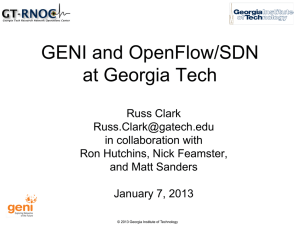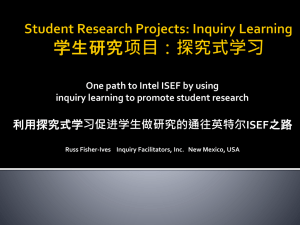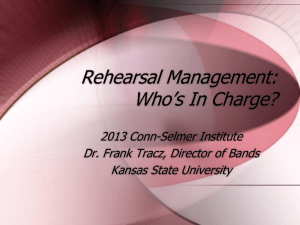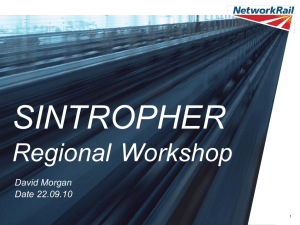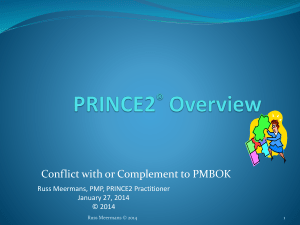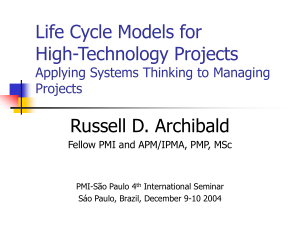Technical Writing2
advertisement
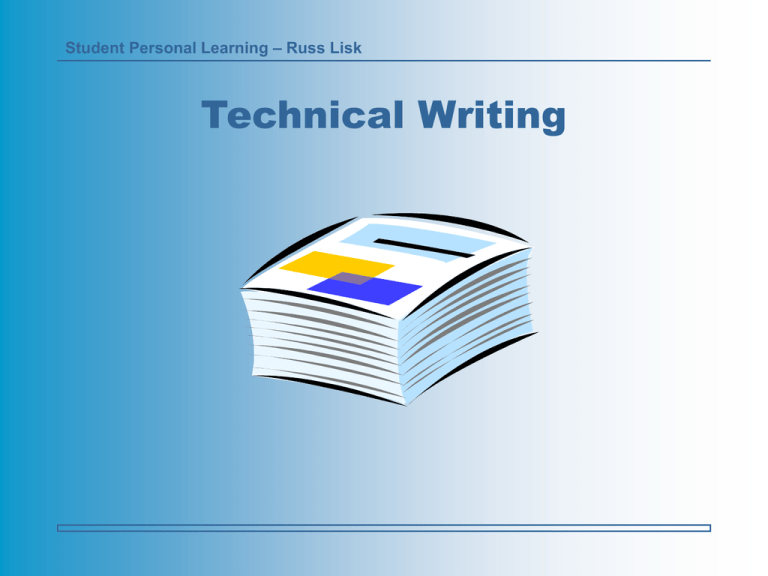
Student Personal Learning – Russ Lisk Technical Writing Student Personal Learning – Russ Lisk Scientific Report Writing>Aims and Objectives Aims and Objectives of this Workshop Aim: To get students thinking about what characterises a meaningful technical report and provide some hints and tips that, if implemented, have the potential to improve the quality of a technical report produced by them 1. List the sections of a brief technical work in their established sequence 2. Identify the considerations associated with each section 3. Identify general considerations related to technical writing 4. Discuss your concerns related to scientific report writing Student Personal Learning – Russ Lisk Table of Contents • • • • • • • Why Words in Mathematical Science? The Introduction The Main Body The Conclusion Title Choice Reference List General Writing Style Student Personal Learning – Russ Lisk • General writing style: – – – – – – – Integrating others’ work Critical thinking Spelling grammar and punctuation Writing in the correct voice Logical, methodical and coherent Substantiated content Formal writing style Student Personal Learning – Russ Lisk Why Words in Mathematical Science? Student Personal Learning – Russ Lisk Why Write in the Field of Mathematics • The first language of the World is the written word not the language of written numbers and • The first written language of the global scientific and technical community is English So • As much as you may be conversant in the conventions of communicating in numbers you need to be conversant in the conventions of communicating in words in English Student Personal Learning – Russ Lisk • As Mathematicians have important contributions to make in all areas of society… • …and if they are to make their contributions they have to communicate their ideas… • …and if the first universal means of communication is the written and spoken word… • … then mathematicians have to communicate effectively in words to broadcast their ideas and effect change! Student Personal Learning – Russ Lisk The Introduction Student Personal Learning – Russ Lisk The Introduction > Characteristic of quality • A well written technical piece will include and well crafted introduction Student Personal Learning – Russ Lisk The Introduction > How do you do it • 3 primary functions 1. To make clear to the reader the precise subject to be considered 2. To indicate the writer’s attitude towards this subject 3. To lay out the plan for its treatment (Nelson 1947) These will now be dealt with in turn Student Personal Learning – Russ Lisk 1. To make clear to the reader the precise subject to be considered • Fix in the mind of the reader the subject for attention • Define the subject • Emphasise the value of the subject to the reader • Limits of subject coverage Student Personal Learning – Russ Lisk 2. To indicate the writer’s attitude towards this subject • How is the subject going to be handled/ treated • What is the purpose of your piece • In your case part of the treatment is the application of theory to the real world • But your full treatment should be more detailed* Student Personal Learning – Russ Lisk 2. To indicate the writer’s attitude towards this subject • “it is most important for a writer always to think of the report or paper he is about to write as having a definite work to perform… …if one conceives his writing in this way, he will not be shooting aimlessly into the air… …He will be learning to aim accurately and shoot to kill” (Nelson 1947 p. 42) Student Personal Learning – Russ Lisk 2. To indicate the writer’s attitude towards this subject • “If before he begins a paper, a reader understands what the writer proposes to do for him, what emphasis he expects to maintain consistently throughout, what point of view he is planning to assume… …the reader can get what he is supposed to get with much less effort than if he gropes his way through a maze of material with no preliminary notion of where he is being led” (Nelson 1947 p.44) Student Personal Learning – Russ Lisk 2. To indicate the writer’s attitude towards this subject > How do you find your focus? • Spontaneous genesis of an idea • More likely to gain inspiration from the World around you this may come from: – – – – – Physical interaction with the real-world Background reading Listening to others thoughts and opinions Watching television Lecture materials Student Personal Learning – Russ Lisk 2. To indicate the writer’s attitude towards this subject > How do you find your focus? • If the ideas are not flowing try: – Doing some more subject reading but specifically think about what you are reading in terms of its real-world application – Take up others’ pleas for assistance – Think about your own physical interactions with the world and ask yourself which mathematical thinking could have been applied to them – Your ideas? Student Personal Learning – Russ Lisk 3. To lay out the plan for its treatment • You need to decide how are you going to organise the main body of your piece to achieve its purpose? • Explain the plan of treatment to give the reader a forward look over the whole area mapped out Student Personal Learning – Russ Lisk 3. To lay out the plan for its treatment > How to construct a plan • You need to have a plan to be able to relate it to the reader in the introduction Student Personal Learning – Russ Lisk 3. To lay out the plan for its treatment > How to construct a plan Introduction X=A+B+C a b A=a+b+c c a1 X b1 B=a1+b1 a2 b2 c2 C=a2+b2+c2+d2 d2 Fig. 1. Example Paragraph Plan to structure a technical piece. = coherence material Conclusion A+B+C=X Student Personal Learning – Russ Lisk 3. To lay out the plan for its treatment > How to construct a plan • To what level of detail would you relate to the plan in the introduction?* Student Personal Learning – Russ Lisk The Main Body Student Personal Learning – Russ Lisk The Main Body > Characteristics of quality • There are a number of considerations specific to you discipline that should be followed in a technical piece • These are outlined on the handout provided and should be studied to learn from them Student Personal Learning – Russ Lisk Conclusion Student Personal Learning – Russ Lisk Conclusion > Characteristic of quality • Make sure you have a conclusion or ‘terminal section’ and one that is well crafted Student Personal Learning – Russ Lisk Conclusion > How do you do it • This section is your last chance to influence the reader of your technical piece. It: – tells the reader the key things you want them to remember from the other sections and what they all mean together – Checks your reader has got the essential idea – Gives your reader the impression that you achieved what you set out to do – It doesn’t introduce new information except to reinforce conclusions and/or recommendations made Student Personal Learning – Russ Lisk Conclusion > How do you do it • You can remind the reader of the purpose of your technical piece • You can make a summary restatement of the points covered • You can reinforce the impression of the pattern the piece took* by briefly revisiting it • You can say something that you hope will leave a lasting impression on your reader Student Personal Learning – Russ Lisk Conclusion > How do you do it • Conclusions are only really hard to write if you never had a purpose or you have lost that purpose along the way • To help you know better what to write – Remind yourself of what you set out to achieve. What the point of your design was – Ask yourself what do you want the reader to really take away with them Student Personal Learning – Russ Lisk Conclusion > How do you do it • Knowing what to say to conclude a technical piece can be helped by knowing the ‘family’ of report to which it belongs: • Factual • Critical • Advisory Student Personal Learning – Russ Lisk Conclusion > How do you do it • Other consideration that might help you: – What is the significance of your findings? – What are the implications of your conclusions for this topic and for the broader field – Where there limitations to your approach – Are there any other factors of relevance that impact upon the topic, but fell outside the scope of your piece – Are there any suggestions you can make in terms of future research Student Personal Learning – Russ Lisk Title Student Personal Learning – Russ Lisk Title > characteristic of quality: • To include a title and one that is informative and enticing • Your work's title can be as long or a short as it needs to be to achieve the criterion of an effective title Student Personal Learning – Russ Lisk Title Choice > How to do it: • Revise the examples provided to emulate the principles outline in them for your own title Student Personal Learning – Russ Lisk General Writing Style Student Personal Learning – Russ Lisk Critical thinking Student Personal Learning – Russ Lisk Critical thinking > Characteristic of quality • In any degree you are expected to demonstrate that you consider the world around you critically • This way of thinking about the world around you should come through in the way in which you write Student Personal Learning – Russ Lisk Critical thinking > How do you do it? • There area two potential areas for development here: There is changing the way you view the world around you and Developing writing strategies the prove that you consider the world in a critical way and that present information to others so that they may think the same Student Personal Learning – Russ Lisk Critical thinking > How do you do it Changing the way you view the world Student Personal Learning – Russ Lisk Critical thinking > How do you do it > Changing the way you view the World • Don’t blindly accept the information you are exposed to • Develop a sceptical mind • Be a detective or investigative journalist • Seek the truth • Continually question why something is the way it is Student Personal Learning – Russ Lisk Critical thinking > How do you do it > change the way you write • Don’t write, “the government says” • Write, “the government makes unfounded claims that” Student Personal Learning – Russ Lisk Critical thinking > How do you do it > change the way you write • Don’t write, “the results from Smith & Black show” • Write, “extensive repetitions show that it is highly likely that” Student Personal Learning – Russ Lisk Critical thinking > How do you do it > change the way you write • Don’t write, “50% of people in the UK rate maths as their weakest subject” • Write, “5 studies concur that approximately 50% of people in the UK rate maths as their weakest subject” Student Personal Learning – Russ Lisk Critical thinking > How do you do it > change the way you write • Don’t write, “it is believed that more car crashes occur in the dark” • Write, “it isn’t clear whether more car crashes occur at night or not because the study was only undertaken in Finland in mid winter” Student Personal Learning – Russ Lisk How do you do it > change the way you write • Yes it takes up time to be appropriately critical • Yes it takes up words to be appropriately critical • But if you don’t want to be a sheep and just accept what you are told then you need to be critical Student Personal Learning – Russ Lisk Critical thinking > How do you do it > change the way you write • Trip to the zoo • See the following handout and after 3 minutes of individual study I will ask for the group to vote on which passage is purely descriptive and which is descriptive and critical Student Personal Learning – Russ Lisk Critical thinking > How do you do it > change the way you write Descriptive writing… Critical writing might… states what happened identify the significance of it states what something is like evaluate its strengths /weaknesses says how something is done argue a case for doing something according to evidence explains what a theory says show why a theory is relevant explains how something works indicate why something works (best or better than others) notes methods used note methods used says when something occurred identify why the timing is important states different components weigh up importance of each component states options give reasons for selecting one option over another lists details evaluate relative significance of details lists things in any order prioritise / structure info in order of importance gives information make reasoned judgments and draws conclusions states links between items shows relevance of links Table 2. characteristics of descriptive verses critical writing Student Personal Learning – Russ Lisk Integrating others’ work Student Personal Learning – Russ Lisk Integrating others’ work > Characteristic of quality • In cases of scientific and technical writing it is important to demonstrate that you are engaging with others' work to develop your own thoughts. Student Personal Learning – Russ Lisk Integrating others’ work > How do you do it • Personal Development: – Researching skills - to find others' relevant work* – Reading skills - obtain important information from others' work** – Writing skills - to effectively incorporate others work into your own to demonstrate you are engaging with relevant sources of information. Student Personal Learning – Russ Lisk Integrating other’s work > how to do it • Writing skills: – Use relevant references in your introduction to achieve the first and second purpose of an introduction – Use references to peer reviewed* sources to substantiate your critical judgements** – Use references to peer reviewed sources to strengthen other areas of your work where you have been critical (see table 2. in Critical thinking) – Use referenced material as examples used to demonstrate a point Student Personal Learning – Russ Lisk Spelling, Grammar and Punctuation Student Personal Learning – Russ Lisk Spelling, Grammar and Punctuation > Characteristics of quality • To release work that contains correct spelling, grammar and punctuation* Student Personal Learning – Russ Lisk Spelling, Grammar and Punctuation > How do you do it • Personal development: – Firstly judge whether this is a personal weakness of yours and if it is devise plans to develop your skills* • Techniques for development include: – better time management so that you have time to proof your own work – practice increasing your typing accuracy and speed – read instructive resources designed to help people learn correct grammatical and punctuation techniques** – When you’re reading pay more attention to the grammar and punctuation Student Personal Learning – Russ Lisk Writing in the correct voice Student Personal Learning – Russ Lisk Writing in the correct voice – Characteristic of Quality • To write consistently in the voice expected in your discipline Student Personal Learning – Russ Lisk Writing in the correct voice – How to do it • In ‘Writing for the Mathematical Sciences’ by Higham (1998) it is acceptable to write in the first personal plural • That means using ‘we’ • E.g: – “We can see by applying this equation to…” And – “if we are a little more cautious in our assumptions…” Student Personal Learning – Russ Lisk Logical, Methodical and Coherent Student Personal Learning – Russ Lisk Logical, Methodical and Coherent > Characteristic of Quality • A piece that flows (is coherent) makes the difference between a frustrating encounter and a blissful enlightening journey Student Personal Learning – Russ Lisk LMC > How do you do it • Always have the purpose of your piece in mind • Plan the paragraph structure* and follow it • ‘Signpost’ the reader between sentences and between paragraphs Student Personal Learning – Russ Lisk Logical, Methodical and Coherent > How to do it •Signposting Introductory topic sentence Student Personal Learning – Russ Lisk Logical, Methodical and Coherent > How to do it • Introductory topic sentence examples: – “Let us begin with the UK, the first European country to organise its broadcasting on a national scale” – “We now focus on the case of 1 x 1 matrices – Scalars – “It is important to consider the Central Limit Theorem in any analysis of sample size Student Personal Learning – Russ Lisk Logical, Methodical and Coherent • Long paragraphs cantohave a concluding > How do it topic sentence at the end Concluding topic sentence Student Personal Learning – Russ Lisk Logical, Methodical and Coherent > How to do it • Concluding topic sentence examples: – “Thus it has been demonstrated that…” – “These factors all lead to the same conclusion that… – “these few studies limit the degree to which the matter has been investigated Student Personal Learning – Russ Lisk Logical, Methodical and Coherent > How to do it • Transitional Text • May come at the beginning of a paragraph to link backwards to a previous paragraph Transitional text Student Personal Learning – Russ Lisk Logical, Methodical and Coherent > How to do it • Transitional text examples followed by topic sentences in italics – Having completed the survey and determined the reason why the plan has thus far been a failure, it will next be necessary to consider whether it can still be made to work – All these facts would seem to justify the objections of our clients, which will now be taken up in detail Student Personal Learning – Russ Lisk Logical, Methodical and Coherent > How to do it • In complex and long technical pieces it may be necessary to have a transition paragraph a b c Transitional paragraph summarising paragraphs a, b and c and referring to d d Student Personal Learning – Russ Lisk Logical, Methodical and Coherent > How to do it • Use headings and if necessary sub headings • Make those headings meaningful Student Personal Learning – Russ Lisk Logical, Methodical and Coherent > How to do it • Linking words and phrases between sentences within paragraphs • For linking phrases see: http://www.phrasebank.manchester.ac.uk • For linking words see: http://www.surrey.ac.uk/library/splash/online/s tudyguides/Essay_Writing.pdf Student Personal Learning – Russ Lisk Summary • Not all facets of technical writing covered • Summary of what was covered Student Personal Learning – Russ Lisk Reference List • Higham, N. J. Handbook of writing for the mathematical sciences. 2nd Ed. SIAM: Philadelphia • Nelson, J. R. (1947) Writing the technical report. 2nd Ed. McGraw-Hill Book Company Inc: New York

